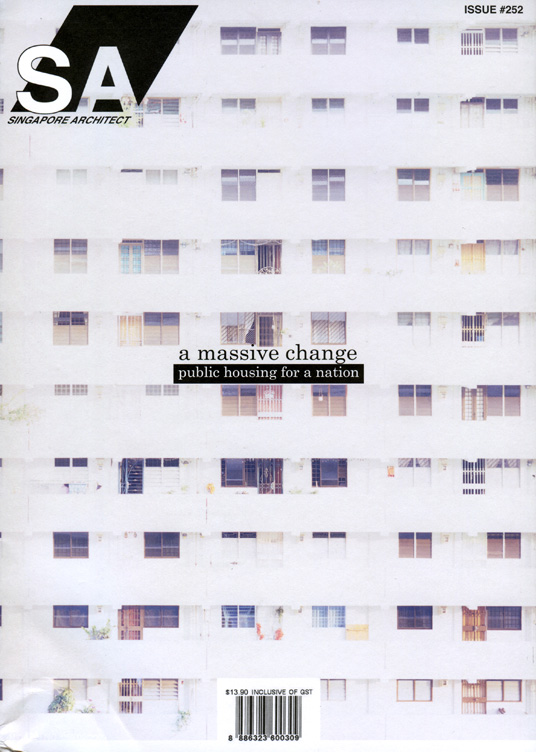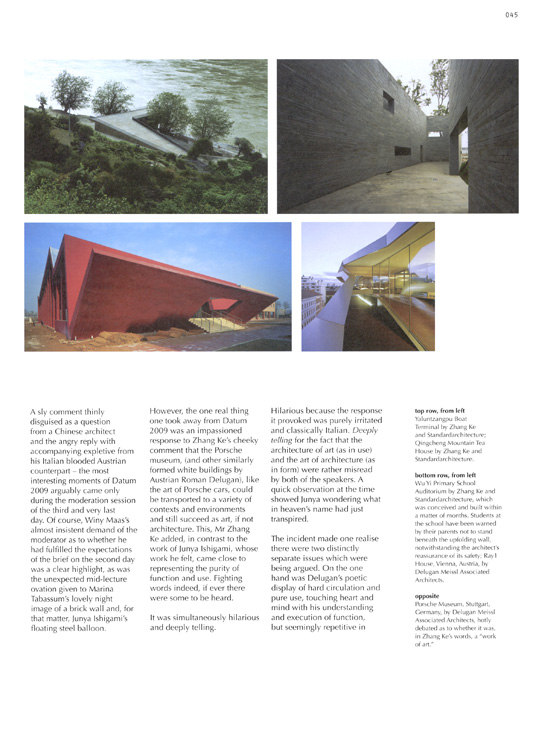Basic by design
01 September 2009


DATUM: KL 2009
TEXT BY KEVIN MARK LOW
IMAGES COURTESY OF THE RESPECTIVE ARCHITECTS, AND PERTUBUHAN AKITEK MALAYSIA (PAM; THE MALAYSIAN INSTITUTE OF ARCHITECTS)
As the SIA readies itself for Archifest 2009, its Malaysian counterpart PAM recently hosted Datum: KL at the Kuala Lumpur Convention Centre. With "Basic Design: the New Intelligence?" as its poser, the forum invited international speakers to deal with the subject in culturally diverse ways. The speakers this year included Dutch architect Winy Maas, China's Zhang Ke, Japan's Junya Ishigami, Malaysian Hud Abu Bakar, Briton Stephen Pimbley and Austrian architect Roman Delugan. The moderator for the event was Lawrence Liauw from the Chinese University of Hong Kong. Kevin Mark Low recounts what he took away from the forum.
A sly comment thinly disguised as a question from a Chinese architect and the angry reply with accompanying expletive from his Italian blooded Austrian counterpart - the most interesting moments of Datum 2009 arguably came only during the moderation session of the third and very last day. Of course, Winy Maas's almost insistent demand of the moderator as to whether he had fulfilled the expectations of the brief on the second day was a clear highlight, as was the unexpected mid-lecture ovation given to Marina Tabassum's lovely night image of a brick wall and, for that matter, Junya Ishigami's floating steel balloon.
However, the one real thing one took away from Datum 2009 was an impassioned response to Zhang Ke's cheeky comment that the Porsche museum, (and other similarly formed white buildings by Austrian Roman Delugan), like the art of Porsche cars, could be transported to a variety of contexts and environments and still succeed as art, if not architecture. This, Mr Zhang Ke added, in contrast to the work of Junya Ishigami, whose work he felt, came close to representing the purity of function and use. Fighting words indeed, if ever there were some to be heard.
It was simultaneously hilarious and deeply telling.
Hilarious because the response it provoked was purely irritated and classically Italian. Deeply telling for the fact that the architecture of art (as in use) and the art of architecture (as in form) were rather misread by both of the speakers. A quick observation at the time showed Junya wondering what in heaven's name had just transpired.
The incident made one realize there were two distinctly separate issues which were being argued. On the one hand was Delugan's poetic display of hard circulation and pure use, touching heart and mind with his understanding and execution of function, but seemingly repetitive in the forms that he wrapped his functional relationships within. And on the other, Junya's work, ephemeral if otherwise seemingly functional in form, but almost entirely effect obsessed as art from the viewpoint of actual use. These are indeed important distinctions as they support fully, both Zhang Ke's comment and Roman's clipped reply. Delugan was completely correct and consistent that he did not believe his work was art and, as evidenced by his subtle and thoughtful treatment of functional and organisational relationships, art is indeed irrelevant – he had simply assumed that the comment was made with reference to the carefully studied functions and not the white forms his work was wrapped in! Zhang Ke, obviously more comfortable with formalistic work, had referred instinctively and purely to the appearance of the work he had viewed during Delugan's presentation and, from a purely formal perspective at least, appeared to be justified in his critique of Roman's white and silvery shells.
At the evening's end, however, with strange but warm friendships made, irritations were bound to soften and critique forgotten. In a conversation with Roman over dinner, he admitted that he had never quite given deeper thought to the differences between the art of his forms and the deeper considerations he had given functional and operational relationships. Zhang Ke was a touch less coherent with beer in the belly, but it mattered less - from the overview of his presentation during Datum itself, it was clearer where he stood: one might have slighted Roman Delugan's response as unjustifiably defensive, but a reading of the situational sub-text actually revealed quite the opposite. It could be argued that the work of both the Chinese and Japanese architect were actually more form driven, despite the greater individual differences in the expression of the forms of their work and the more blatantly similar forms of Delugan's architecture.
One commonly asks questions at and of architectural seminars and forums: the main thought on everyone's minds is if any answers will be forthcoming. The thing that one came away with a clear sense of, was the fact that the speakers were taking the theme of basic design for this year's symposium a touch more seriously, regardless if it was actually addressed more thoroughly. What felt to be missing, however, was the final round up. A summary of the presentations made in relation to "Basic Design: The New Intelligence?" felt only marginally successful in its delivery of satisfactory answers, even though all the cues were there for the drawing of conclusions. The moderator Lawrence Liauw cannot quite be faulted entirely, however, as conclusions are always more obvious in retrospect – the theme was a tough one to moderate.
To be sure, there was something basic in every one of the work presentations. Alastair Hall, Zhang Ke, Junya, Han Tumertekin, Eric Howeler and Meejin Yoon clearly brought similar interpretations to what basic meant to them in the way of the act of building and making, with Junya edging the show with substantial background on how his designs were realised, with an equally provocative minimalist glass city insert: four floors of a house, each respectively containing a kitchen, a bed, a wardrobe and a bathroom clearly constitutes lots of basic. If disappointment was to be found, it would have been because Han and Alastair had not provided sufficient treatment concerning the details of their work. Hud Abu Bakar's take on the subject flipped from issues of sustainability to those of form, and ideas for ventilation to those of the ever-changing perspectives of a downtown high-rise: his was possibly the only presentation which chose not to address the theme. Delugan interpreted basic as that which concerned the patterns of human activity, use and occupation - an interesting viewpoint too often missed by architects generally and misinterpreted by our Chinese speaker specifically. Marina, unfortunately, had decided to end the presentation of her delightfully intriguing built work about ten minutes into her show and then proceeded to speak about the geometries of her mosques and the detached austerity of an incomplete civic monument, without going into greater detail on much of anything; remarkable work, although a touch too removed for deeper engagement. Stephen Pimbley built up his presentation with great promise, had a rocking ovation with a set of slides mocking poor Michael Graves and another architect's somewhat tasteless project in the Middle East, then promptly ended what would have been an engaging show, by the faux- pas of what one might have deemed an equally tasteless glass lotus of his own, burping its way through the atrium of a commercial development in China. Ah, well.
The most considered presentation with respect to Basic Design was arguably Winy Maas's, with ideas of pig condominiums; lightweight rooftop housing and floodplain rebuilding; a library as the beacon hill for a blue-collar community; and a collection of projects which challenged our way of interpreting building program. His was a deep engagement of the often neglected soft issues of architecture, a re-telling of the basics which precede and narrate design. One could see where Danish architect Bjarke Ingels possibly began learning his irreverent treatment of narrative and programmatic issues, although the case could be made that Mr Ingels has, arguably, taken the art to a new and more convincing level. However, with Winy on song, it was no wonder he was at his aggressive best during the moderation session of the second day, asking Lawrence if he had indeed answered the demands of the brief that the speakers had to go far beyond the show-and-tell sessions which typify seminars of this sort.
"Have we lived up to expectation?" he asked. "Have we," he demanded, "addressed the brief?"
A datum is, technically speaking, a given or standard reference point from which measurements are taken. In the particular case of Datum 2009, were we to believe that the reference point is simply what Winy Maas suggests, as the re-narration of soft issues which touches the mind and the heart from a functional viewpoint, but leaves our hearts untouched from a hard formal perspective? Or that it is as Junya Ishigami does, touching heart and mind from a formal hard viewpoint but not very well from that of function? Or perhaps it is from Roman Delugan's elegant display of hard circulation and use, touching heart and mind with his understanding and execution of function, but seemingly repetitive in the forms he wraps his functional relationships within?
One might have felt that each speaker did present a viable point of reference, and they would probably be correct that to ask which one of them actually addressed the theme best would be invitation to miss a subtle point: the simple fact of the matter is that there is absolutely nothing basic about design. The only fact which one can absolutely rely on as being true about design, is that it is unsparingly inclusive - basic design is the gracious confluence of everything that was presented at the seminar. The speakers were all correct in their identification of the various aspects of design, but no one speaker put it all together in a way that left both our hearts and minds equally touched: design in all its complexity, expects of us the delicate weaving of issues hard and soft into function and form which engage both the mind and the body.
As complexity goes, it is a tall order and hardly basic if one thinks deeply about it. Then again, no one ever said basic design was easy.